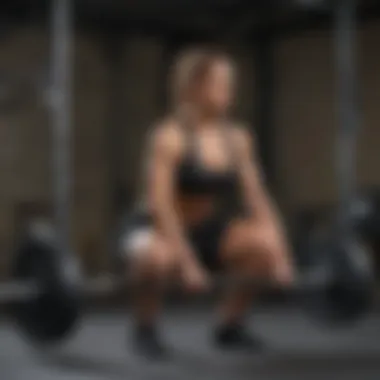Weighted Vest Exercises: Enhance Your Training


Intro
Weighted vests have increasingly gained popularity among fitness enthusiasts. These versatile training tools offer varied benefits across multiple workout routines. By adding resistance, they increase the workload, potentially enhancing strength, endurance, and overall fitness level. However, proper understanding of their usage is crucial to maximize benefits while minimizing injury risk.
This guide aims to explore the practical applications of weighted vests in exercise routines. We will delve into the scientific foundation behind resistance training and outline specific exercises suitable for different fitness levels. Moreover, safety considerations will be highlighted, ensuring that users employ the correct techniques and approaches for effective and safe workouts.
Whether one is a fitness practitioner looking for new training methods or a health professional seeking to augment client training plans, this comprehensive overview will provide critical insights and actionable advice.
Understanding Weighted Vests
Weighted vests have been steadily gaining popularity among fitness enthusiasts, athletes, and trainers. Their significance lies in their ability to augment various physical training regimens. This enhancement is achieved by adding extra resistance to body movements, thus compelling the body to work harder than it would under normal conditions. In understanding weighted vests, it is essential to delve into the mechanics of their design, history, and operational principles.
What is a Weighted Vest?
A weighted vest is a piece of equipment worn during workouts to add resistance. It is typically constructed from durable materials and includes pockets to hold weights. The weights can often be adjusted, allowing users to customize their training intensity. This versatility makes weighted vests suitable for different fitness levels. Whether the goal is to improve strength, endurance, or overall fitness, a weighted vest can play a role in achieving those results.
History and Development
The concept of adding weight to physical activities has been around for centuries. In ancient times, warriors and soldiers often trained with heavy gear to improve strength and stamina. However, the modern weighted vest can trace its formal development to the late 20th century, becoming more widely used in military training and fitness programs. The design has evolved, with advancements in material science allowing for lighter yet more durable options. This evolution reflects the growing recognition of the benefits they offer in a structured training setting.
How They Work
Weighted vests work by altering the body’s mechanics during exercise. When additional weight is added, it increases the overall load that muscles must lift or propel. This adjustment causes the body to recruit more muscle fibers, enhancing strength and endurance over time.
Practically, this means that activities such as running, jumping, or strength training become more challenging and effective. Furthermore, the increased load can stimulate the cardiovascular system, leading to benefits in endurance and calorie burning. Utilizing a weighted vest in training helps in engaging core muscles to maintain stability while performing various movements.
"Incorporating weighted vests in workouts offers unique advantages that challenge the body in new ways."
When used appropriately, weighted vests can lead to noticeable improvements in physical performance, making them valuable tools in fitness regimes.
Benefits of Using Weighted Vests
Weighted vests have become increasingly popular in fitness routines, offering a unique way to enhance training effectiveness. Utilizing a weighted vest during exercise can provide numerous benefits that range from physical conditioning to overall health improvements. Understanding these advantages is essential for anyone looking to elevate their fitness regime.
Enhanced Strength Training
One of the primary benefits of using weighted vests is the enhancement of strength training. When performing exercises with added weight, the muscles experience increased resistance. This added demand stimulates muscle fibers, leading to greater strength gains over time. Weighted vests are particularly effective during bodyweight exercises such as push-ups or squats. By adding resistance, it requires more effort from the muscles, promoting muscle hypertrophy and improvement in overall strength.
Improved Cardiovascular Endurance
Weighted vests can significantly enhance cardiovascular endurance. When engaging in aerobic activities like running or cycling with a weighted vest, the heart and lungs work harder to supply oxygen to the muscles. This increased effort contributes to improved cardiovascular capacity. Athletes often find that incorporating weighted vests into their routines can help in preparing for competitions. The increased load forces the body to adapt, improving efficiency and stamina.
Incorporating a weighted vest into your cardio workouts can lead to quicker gains in endurance, ultimately making your workout more effective.


Increased Metabolic Rate
The addition of weight from a vest affects the body’s metabolic rate. With the body working harder to carry the extra weight, there is an increase in calories burned during and after the workout. This phenomenon, referred to as excess post-exercise oxygen consumption (EPOC), indicates that a greater metabolic rate can enhance fat loss. Given the increasing importance of metabolic health, using a weighted vest can be a sensible approach to boosting caloric expenditure.
Functional Fitness Gains
While traditional strength training focuses on isolated muscle groups, weighted vests promote functional fitness. This term refers to exercises that prepare the body for real-life activities. By integrating a weighted vest into functional movements like lunges, jumps, or agility drills, individuals can experience better balance, coordination, and overall body mechanics. Functional fitness translates directly into daily life, making routine activities easier and more efficient.
Using weighted vests provides a versatile approach to enhancing various aspects of fitness, aligning with individual goals and training styles. Incorporating them into workouts can lead to improved strength, endurance, metabolic rate, and functional performance. These benefits make weighted vests a valuable tool for athletes and non-athletes alike.
Selecting the Right Weighted Vest
Choosing the correct weighted vest is crucial for maximizing the benefits of resistance training. The right vest can significantly enhance performance, while an unsuitable one may lead to discomfort or hinder progress. Key considerations involve weight, fit, and usability. Taking the time to understand these elements can lead to a better workout experience, ultimately advancing one's fitness goals.
Weight Considerations
Personal fitness level
When selecting a weighted vest, understanding personal fitness level is very important. This factor influences how much weight an individual can safely handle, which is key for effective training. A beginner may benefit from a lighter vest, as heavy loads could cause strain or injury. This cautious approach allows for gradual adaptation to increased weight. For someone with more experience, a heavier vest may be more suitable for effectively challenging their strength and endurance.
Additionally, choosing a weight aligned with personal fitness level can help in maintaining motivation. A vest that is too heavy can demoralize, while one that is too light may not yield the desired conditioning effects. Therefore, assessing one’s capabilities is not just a safety measure but also enhances the training experience.
Training goals
Training goals play a significant role in determining the appropriate weight for a weighted vest. Whether the aim is to build strength, improve flexibility, or boost cardiovascular fitness, this will dictate the weight needed. Strength training generally requires heavier weights, while those focusing on endurance may prefer lighter options.
Identifying clear training goals helps in achieving specific outcomes. If the goal is to lose weight, a lighter vest can complement high-rep workouts. Alternatively, for muscle gain, a heavier option might be preferable. Setting the right weight according to these goals is a strategic choice that can lead to more focused and effective training.
Fit and Comfort
Adjustment features
Adjustment features are vital in ensuring a snug and secure fit for the weighted vest. A well-fitted vest minimizes shifting during movement, which can lead to discomfort or distraction. The ability to adjust the weight or straps also allows for customization based on the type of exercise being performed.
This is particularly beneficial for individuals who might engage in varied workout routines. For instance, one might prefer a looser fit for cardio workouts, while tightening it for strength training. Hence, adjustable features enhance usability and comfort, making the vest a better fit throughout different exercises.
Material quality
Material quality is another key element when selecting a weighted vest. High-quality materials ensure durability and comfort. Comfortable fabrics reduce irritation, allowing for longer training sessions without discomfort. Additionally, a sturdy construction is necessary to withstand regular use and potential impacts during exercises.
Choosing a vest made from breathable materials can also increase comfort, especially during high-intensity workouts. Weight distribution within the vest should be even. This prevents imbalances that can lead to poor form and potential injuries. Investing in a vest with superior material can provide greater longevity while enhancing the overall training experience.
Incorporating Weighted Vests in Training
Incorporating weighted vests into training regimens can significantly elevate workout effectiveness. These vests allow for added resistance without compromising movement quality. When strategically integrated, weighted vests improve muscle strength, endurance, and overall fitness capacity. They modify exercises by increasing the effort required, thus pushing the body beyond its typical limitations. This aspect makes them beneficial for various training goals.


Types of Exercises
Strength training exercises
Strength training exercises involve using additional weight to increase muscle strength. Weighted vests in strength training allow for better load management among exercises such as squats, push-ups, and pull-ups. This method effectively increases muscle engagement. One key characteristic is their ability to provide constant resistance through full ranges of motion. This means every rep becomes more challenging, encouraging muscle growth and adaptations. The unique feature of these exercises with vests is the convenience of loading bodyweight moves without using free weights or machines. Although advantageous for enhanced gains, they can be taxing on the shoulders or back if not used properly.
Cardiovascular workouts
Cardiovascular workouts with weighted vests aim to boost heart rate and metabolism. Activities like running, cycling, or even brisk walking become more intense with added weight. The critical aspect is the variation of intensity that vests bring into traditional cardio routines. This makes cardiovascular workouts highly effective in enhancing endurance and stamina. A unique feature is the adaptation of standard cardio routines to fit different fitness levels. While it leads to greater calorie burn, improper use of weighted vests can increase injury risks for runners or those with joint concerns.
Bodyweight movements
Bodyweight movements incorporate using one's weight for resistance, and adding a weighted vest enhances this effect. Exercises like lunges, burpees, or planks can elevate their difficulty with a vest. The key characteristic of bodyweight movements is their accessibility; anyone can perform them regardless of location or equipment availability. The unique feature of incorporating a vest makes these moves part of a progressive training approach. While effective, users must be mindful of their form and limit excess weight to prevent strain.
Sample Workout Routines
Beginner-friendly routines
Beginner-friendly routines with weighted vests focus on building foundational strength and endurance. These routines typically include basic movements like squats, push-ups, and bodyweight lunges to help newcomers adjust to added weight gradually. A critical characteristic is their tailored approach for those new to resistance training. The advantage is a gentle introduction, helping to develop the correct form while building confidence. However, it is essential to start with lighter weights to avoid discouragement through fatigue or injury.
Intermediate enhancements
Intermediate enhancements involve increasing both the difficulty and complexity of workouts. Exercises may include weighted planks, pull-ups, or step-ups with heavier weights. This characteristic introduces variety and pushes limits, essential for progress. One unique feature is the adjustment of rest periods and weight to better challenge the body as it adapts. Though beneficial, individuals must gauge their recovery to prevent overtraining.
Advanced training protocols
Advanced training protocols are designed for seasoned athletes or fitness enthusiasts. Those adhering to these routines often use weighted vests in high-intensity interval training or Olympic lifts. The characteristic focus is on maximizing performance and strength using varied weight selections. One distinguishing feature is the incorporation of multiple compound movements seamlessly. This method can lead to substantial gains, but it requires a solid understanding of technique and personal limits to minimize the risk of injury.
Safety Considerations
Engaging in exercises using a weighted vest can enhance your training but also introduces certain risks if not approached with caution. Ensuring safety while using these vests is paramount for both effectiveness and injury prevention. Proper form and technique, along with awareness of potential injuries, play vital roles in a successful training routine. By prioritizing these elements, you can maximize the benefits of weighted vests while minimizing risks.
Proper Form and Technique
Maintaining proper form during exercises is essential, especially when adding extra weight. The increased resistance from a weighted vest can alter your movement mechanics, making it crucial to focus on maintaining alignment and posture. Here are some key aspects to consider:
- Alignment: Ensure your spine is neutral. Avoid leaning forward or arching your back excessively.
- Joint Position: Pay attention to your knees and hips. They should not extend beyond their respective safe limits during squats or lunges.
- Controlled Movement: Perform each movement slowly and with purpose. Sudden, jerky motions can increase the risk of injury.
- Breathing: Breathe properly throughout the exercise. Exhale on exertion and inhale during the easier phase to improve oxygen flow and support endurance.
Consistently practicing good form will help prevent compensatory movements that may lead to injuries.
Avoiding Common Injuries
Injuries can occur even with the best training intentions. Awareness of how to avoid common pitfalls is essential. Here are some common injuries and preventive measures:


- Back Injuries: Heavy weights can strain your back if your core is weak. Strengthening your abdominal muscles will help you stabilize your spine in movements.
- Joint Stress: Extra weight may result in increased pressure on knees and ankles. Avoid high-impact movements if you are new to weighted vest training. Gradually build your endurance.
- Muscle Strains: Overexerting your muscles can lead to strains. Always start with lighter weights and increase gradually.
- Fatigue-Related Injuries: As fatigue sets in, your form may deteriorate. If you find yourself struggling, stop and rest. Listen to your body.
"Safety first means training smart, not hard."
Using appropriate safety measures will ensure a more enjoyable workout experience.
Progressing with Weighted Vests
Progressing with weighted vests is a crucial component in optimizing the effectiveness of resistance training. As individuals engage in exercises with added weight, understanding how to properly adjust that weight over time becomes essential for continued improvement. The concept of progression not only helps in achieving fitness goals but also in sustaining motivation throughout the training journey.
Adaptation is a fundamental principle in physical training. As muscles adapt to progressively heavier loads, they become stronger. This means that simply maintaining the same weight for extended periods may lead to plateaus. Recognizing when and how to increase the load is important in order to stimulate further muscle growth and enhance overall fitness.
Additionally, safety is a paramount consideration. Gradual progression helps to minimize the risk of injury. This is particularly important in a weighted vest training regimen, where improper adjustment of weight or intensity could result in strains or discomfort.
"Progression is not merely about adding weight; it involves a comprehensive approach to training that considers technique, recovery, and individual response to exercise."
Overall, incorporating a structured approach to progression with weighted vests can yield substantial benefits. It allows for more tailored training regimens that suit the individual's evolving fitness level and goals, thus contributing to a more sustainable approach to exercise.
Adjusting Weight Gradually
When using a weighted vest, adjusting weight gradually is essential for maximizing benefits and avoiding injury. It’s wise to start with a manageable load and increase it as your strength develops. This gradual approach gives muscles time to adapt without overwhelming them.
In practical terms, it is often suggested to increase the weight by no more than 5-10%. Incremental adjustments not only facilitate safer training but also help in sustaining the quality of movement. As your body becomes accustomed to heavier loads, it becomes easier to push the limits further.
Individuals should be aware of their physical limits. Progression should not be dictated solely by external factors but rather by one’s own feelings and performance during exercises. Regular self-assessment will help in deciding when it is appropriate to add weight.
Increasing Exercise Intensity
Alongside adjusting weight, increasing the intensity of workouts is another key aspect of progressing with weighted vests. Intensity can be enhanced through various methods, including changing the type of exercise, adjusting speed, or altering the volume of work done (sets and repetitions).
For instance, if you consistently perform push-ups with a weighted vest, you might increase intensity by altering the tempo. Slowing down your push-ups can significantly amplify the exertion required. Alternatively, you can elevate the vest’s weight while keeping the same number of repetitions, thereby increasing the overall intensity of the workout.
Also, consider varying routines. Incorporate high-intensity interval training (HIIT) or circuit training while wearing a weighted vest. This variability not only makes the workouts more engaging but also challenges the body in new ways, promoting adaptation and growth.
By focusing on these progressive techniques, you increase the effectiveness of your training and maintain a steady progression towards your fitness objectives.
Epilogue
The conclusion serves as a crucial aspect of this article. It not only summarizes important information provided about weighted vests but also reinforces their significance in fitness training. Understanding the role of weighted vests is essential for anyone looking to elevate their workouts.
The Role of Weighted Vests in Fitness
Weighted vests are becoming a staple in fitness routines across various levels. These training tools offer a versatile approach to exercising. They promote an increase in strength, endurance, and overall physical performance. With the added resistance, users engage more muscle fibers, leading to better results.
Weighted vests support various types of exercises. They can be integrated into strength training, cardiovascular workouts, or bodyweight movements. For individuals aiming to boost their training effectiveness, these vests provide an efficient way to achieve that goal.
Key Points to Consider
- Adaptability: The versatility of weighted vests accommodates all fitness levels. Beginners can start with lighter weights, while advanced users can increase the load gradually.
- Practicality: Weighted vests allow individuals to enhance routine exercises without needing additional equipment. This practicality makes them an excellent choice for home workouts or outdoor training.
- Increased Engagement: By adding weight, individuals can experience enhanced muscle engagement. This leads to greater strength development and endurance over time.
Weight vests also help in preventing injuries when used correctly. Proper technique is essential to maximize benefits while minimizing risks. As users progress, they can increase weights systematically. This approach ensures continuous improvement and avoids overtraining.







